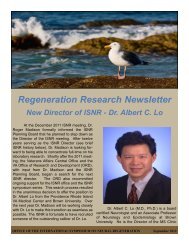Upper-Limb prostheses
Upper-Limb prostheses
Upper-Limb prostheses
You also want an ePaper? Increase the reach of your titles
YUMPU automatically turns print PDFs into web optimized ePapers that Google loves.
Research Recommendations<br />
for <strong>Upper</strong> Extremity Prosthetics<br />
T. Walley Williams III, MA<br />
Richard Weir, PhD<br />
Craig Heckathorne, MSc<br />
Jack Uellendahl, CPO<br />
Domenic Reda, PhD<br />
Oren S. Ganz, MOT, OTR/L<br />
Stephen Jacobsen, PhD<br />
William J. Howard III, MSS, OTR/L, CHT<br />
Denise Burton, PhD<br />
Nov. 17-18, 2003
<strong>Upper</strong> Extremity Research Timeline<br />
NOW<br />
5 YEARS<br />
10 YEARS<br />
ENERGETICS<br />
*Track commercial developments of<br />
batteries & alternative power<br />
sources<br />
CONTROL<br />
*Pattern recognition / multifunctional<br />
control<br />
*Clinical evaluation of EPP systems<br />
*Implantable myoelectric sensors<br />
*Close the loop using stimulations<br />
(feedback for myoelectric)<br />
Neural control using peripheral<br />
nerves<br />
SUSPENSION<br />
*Implement self-suspending (AE)<br />
techniques - Harness for control<br />
*Criteria for osseointegrated upperlimb<br />
<strong>prostheses</strong><br />
*Develop models to evaluate<br />
harness and suspension<br />
techniques and physiological<br />
loading<br />
COSMETICS<br />
*Durable High Definition Gloves<br />
MECHANISMS<br />
*Hybrid power elbows<br />
*Robust locking shoulders<br />
*Compliant hands<br />
*3 function / 2 DOF wrists<br />
*Teach commercial developments<br />
in alternative activation technology<br />
*Lighter powered elbows with near<br />
physiological function<br />
OUTCOMES<br />
*Design study to follow WRAMC<br />
amputees<br />
*Implement / adopt current<br />
evaluation techniques to this<br />
amputee population.<br />
*Develop tests to measure<br />
component outcomes<br />
*Create database of veterans fit<br />
with upper limb <strong>prostheses</strong> for<br />
retrospective studies of prosthetic<br />
intervention - successes / failures
Goals for New Research<br />
1. Give trans-radial amputees full simultaneous control of three wrist<br />
functions and at least two hand functions (e.g. implantable<br />
electrodes, pattern recognition schemes)<br />
2. Promote investigation of nerve-muscle grafts at the trans-humeral<br />
level for control of the elbow and hand/wrist functions<br />
3. Improve suspension methods/alternatives<br />
4. Promote surgical/prosthetic methods to achieve active internalexternal<br />
rotation of the forearm by users of trans-humeral <strong>prostheses</strong><br />
5. Give shoulder disarticulation amputees a functional shoulder joint<br />
6. Improve/promote control methods that incorporate feedback of<br />
position, velocity, and force (e.g. body-powered cable systems, and<br />
powered E.P.P.-type systems, miniature cineplasty interfaces)<br />
7. Identify power sources with greater energy density<br />
8. Utilize WRAMC as a model to promote team approach to care of<br />
persons with arm amputations and to develop outcome measures<br />
9. New components and coverings<br />
10. Surgical interventions
Required to support Goal 1:<br />
Research on Implantable Myosignal Transducers<br />
! Will permit acquiring signals from individual superficial<br />
and deep muscles<br />
! Potential of mapping muscles onto the control of<br />
appropriate mechanisms (e.g. supinator to control<br />
supination of wrist rotator)<br />
! Potential for simultaneous control of multiple functions<br />
! Available in three – five years<br />
! Explore closing control/feedback loop with implanted<br />
stimulators (BION)<br />
– Five - ten years
Required to support Goal 1:<br />
Multifunction Control for the Trans-radial<br />
! Greater number of control sources (with<br />
implantable electrodes or pattern recognition<br />
schemes) opens up the possibility of more<br />
functions<br />
! New wrist components<br />
– Powered wrist flexion; powered radial/ulnar deviation;<br />
powered pronation/supination; combined actions in<br />
single device<br />
! Hands with separate thumb positioning and grip<br />
control<br />
– Compliant grasping
Required to support Goal 2:<br />
Research to Implement Nerve-muscle Grafts<br />
! Sponsor research on identifying functional nerve<br />
fasicles in the operating room for assisting the<br />
neurosurgeon during reimplantations and for<br />
doing these new nerve attachments<br />
! Discover best ways to isolate reinnervated partial<br />
muscles to minimize cross talk<br />
! Additional funding would accelerate the pace of<br />
this research<br />
! Funding is also needed to replicate the technique<br />
at other centers
Required to support Goal 3:<br />
Improving Suspension<br />
! At the trans-humeral level<br />
– Marquardt-Neff angulation osteotomy (retains physiological humeral<br />
rotation and provides suspension)<br />
– implanting a titanium T in the end of the humerus (Christiansen et al in<br />
Norway)<br />
! Identify appropriate levels for osseointegration<br />
– Trans-humeral fittings to date have been only cosmetic <strong>prostheses</strong> – why?<br />
– Possibilities for the shoulder disarticulation ?<br />
! Suspension methods that do not rely on body harness would free up<br />
harness for control only could improve comfort and acceptance of user<br />
– Examples: suction sockets; suspension sleeves; osseointegration<br />
! Develop models to evaluate harness and suspension techniques and<br />
physiological loading
Partly supports Goal 4:<br />
Control of internal-external rotation<br />
! Replace humeral rotation friction joints with<br />
lockable components<br />
– Both mechanical and electric lock/unlock options<br />
! Develop electric powered positioning component<br />
– double no-back clutch<br />
– low power<br />
! Investigate use of implanted magnet at end of the<br />
humerus to control motion of internal-external<br />
rotation
Partly supports Goal 5:<br />
Improve the Locking Shoulder Joint<br />
! Must be reliable for a heavy user for five years<br />
! The lock should be as easy to operate manually or<br />
with a cable as a typical alternator<br />
! An instant-action electric lock is also needed<br />
! Provide a lock in abduction<br />
! Abduction needs gravity compensation as<br />
provided in the Bock AFB
Supports Goal 6:<br />
Force or Position Servo Control<br />
! EPP (Extended Physiological Proprioception) Servo<br />
systems can give greater feedback to the user and are<br />
independent of myoelectric control<br />
– most useful when the device driven can move at<br />
physiological speeds<br />
! Servo control requires a “sleep” or set-it-and-forgetit<br />
circuit<br />
! This technology is ready to implement<br />
– A good position feedback kit for Bock hands already exists<br />
and the Boston elbow has the required circuits but should<br />
be faster for EPP
Supports Goal 7:<br />
Energy Dense Power Sources<br />
! Improvements in energy storage are driven by<br />
large markets like cellular phones<br />
! Manufacturers of powered prosthetic components<br />
will monitor these developments without further<br />
outside help.
Supports Goal 8:<br />
WRAMC as Model for Team Amputee Care<br />
! WRAMC to use or rework existing manipulative tests to<br />
quantify current amputee performance<br />
! Develop outcome measurement tools appropriate to the<br />
relatively smaller upper-limb amputee population.<br />
! WRAMC/VA could track amputees for retrospective<br />
studies of success/ failure/ preferences of upper-limb<br />
prosthetic fittings<br />
– WRAMC fits each person with three types of <strong>prostheses</strong> (bodypowered,<br />
myoelectrically-controlled, aesthetic)<br />
» Unique opportunity unavailable at this scale in the private sector<br />
– Identify relevant factors when prosthesis use is abandoned<br />
– Identify psychological effects relevant to integration of prosthesis<br />
into body image
Supports Goal 8:<br />
WRAMC as Model for Team Amputee Care<br />
! Develop amputee focus groups to identify areas requiring<br />
improvement<br />
– User’s perspective<br />
– Participant should have at least one year of experience using a<br />
prosthesis<br />
» Allows for time to make psychosocial adjustment<br />
» Judgments based on experience<br />
! Newly-amputated person generally has unrealistic expectations<br />
» Experience helps in prioritizing importance of identified areas<br />
! Consider use of VA QUERI group to provide ongoing<br />
review of research/procedures pertinent to WRAMC/VA<br />
needs in upper-limb amputee care
Supports Goal 9:<br />
Components and Coverings<br />
! Continue research on body-powered components<br />
– Have many features desired by users but also have deficiencies<br />
! Existing devices need to be lighter to incorporate more<br />
active joints within a given prosthesis<br />
! New devices need to emphasize lightweight design<br />
– Get input from DOD and NASA, and other government agencies /<br />
private sector manufacturers on lightweight materials<br />
! Durable, high definition cosmetic gloves<br />
! Hybrid elbows with power assist/body-power actuation<br />
! Revisit VA-sponsored research from last 20 years to see<br />
which projects failed “technology transfer” and need a<br />
second try<br />
– Technologies come of age and become ready for implementation
Partly supports Goal 10:<br />
Surgical Issues<br />
! Is their value to lengthening the humerus or the radius and<br />
ulna for prosthetic fitting<br />
– What are the criteria?<br />
! Educate the surgical community on the need for myodesis<br />
and myoplasty to prepare the residual limb for prosthetic<br />
fitting<br />
! Consideration of the Krukenberg procedure or the Wilkie<br />
procedure for blinded individuals with bilateral arm<br />
amputations<br />
– Provides sensation<br />
– Could be covered with aesthetic prosthesis for social purposes
<strong>Upper</strong> Extremity Research Timeline<br />
NOW<br />
5 YEARS<br />
10 YEARS<br />
ENERGETICS<br />
*Track commercial developments of<br />
batteries & alternative power<br />
sources<br />
CONTROL<br />
*Pattern recognition / multifunctional<br />
control<br />
*Clinical evaluation of EPP systems<br />
*Implantable myoelectric sensors<br />
*Close the loop using stimulations<br />
(feedback for myoelectric)<br />
Neural control using peripheral<br />
nerves<br />
SUSPENSION<br />
*Implement self-suspending (AE)<br />
techniques - Harness for control<br />
*Criteria for osseointegrated upperlimb<br />
<strong>prostheses</strong><br />
*Develop models to evaluate<br />
harness and suspension<br />
techniques and physiological<br />
loading<br />
COSMETICS<br />
*Durable High Definition Gloves<br />
MECHANISMS<br />
*Hybrid power elbows<br />
*Robust locking shoulders<br />
*Compliant hands<br />
*3 function / 2 DOF wrists<br />
*Teach commercial developments<br />
in alternative activation technology<br />
*Lighter powered elbows with near<br />
physiological function<br />
OUTCOMES<br />
*Design study to follow WRAMC<br />
amputees<br />
*Implement / adopt current<br />
evaluation techniques to this<br />
amputee population.<br />
*Develop tests to measure<br />
component outcomes<br />
*Create database of veterans fit<br />
with upper limb <strong>prostheses</strong> for<br />
retrospective studies of prosthetic<br />
intervention - successes / failures

















